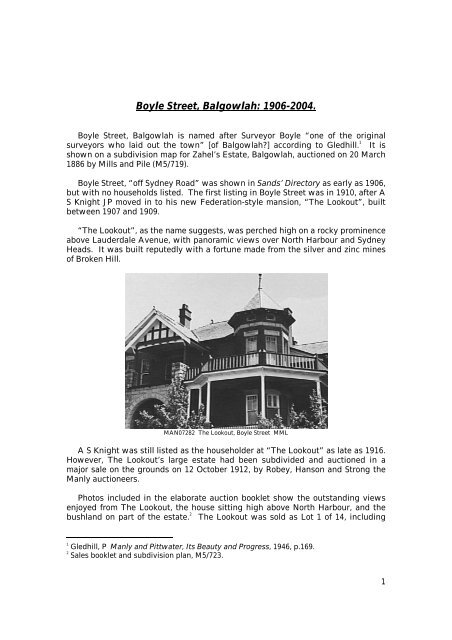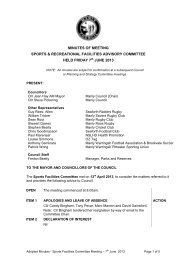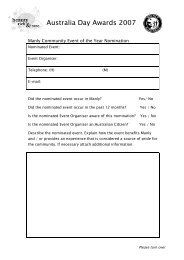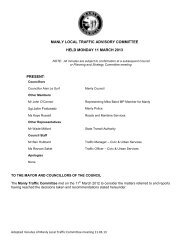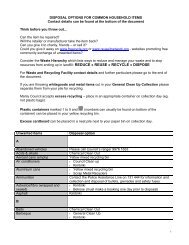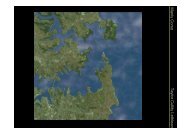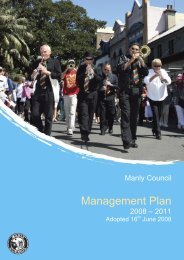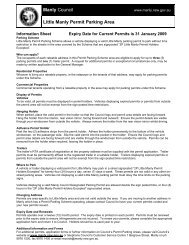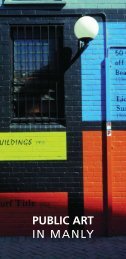Boyle Street, Balgowlah: 1906-2004. - Manly Council
Boyle Street, Balgowlah: 1906-2004. - Manly Council
Boyle Street, Balgowlah: 1906-2004. - Manly Council
You also want an ePaper? Increase the reach of your titles
YUMPU automatically turns print PDFs into web optimized ePapers that Google loves.
<strong>Boyle</strong> <strong>Street</strong>, <strong>Balgowlah</strong>: <strong>1906</strong>-<strong>2004.</strong><strong>Boyle</strong> <strong>Street</strong>, <strong>Balgowlah</strong> is named after Surveyor <strong>Boyle</strong> “one of the originalsurveyors who laid out the town” [of <strong>Balgowlah</strong>?] according to Gledhill. 1It isshown on a subdivision map for Zahel’s Estate, <strong>Balgowlah</strong>, auctioned on 20 March1886 by Mills and Pile (M5/719).<strong>Boyle</strong> <strong>Street</strong>, “off Sydney Road” was shown in Sands’ Directory as early as <strong>1906</strong>,but with no households listed. The first listing in <strong>Boyle</strong> <strong>Street</strong> was in 1910, after AS Knight JP moved in to his new Federation-style mansion, “The Lookout”, builtbetween 1907 and 1909.“The Lookout”, as the name suggests, was perched high on a rocky prominenceabove Lauderdale Avenue, with panoramic views over North Harbour and SydneyHeads. It was built reputedly with a fortune made from the silver and zinc minesof Broken Hill.MAN07282 The Lookout, <strong>Boyle</strong> <strong>Street</strong> MMLA S Knight was still listed as the householder at “The Lookout” as late as 1916.However, The Lookout’s large estate had been subdivided and auctioned in amajor sale on the grounds on 12 October 1912, by Robey, Hanson and Strong the<strong>Manly</strong> auctioneers.Photos included in the elaborate auction booklet show the outstanding viewsenjoyed from The Lookout, the house sitting high above North Harbour, and thebushland on part of the estate. 2The Lookout was sold as Lot 1 of 14, including1Gledhill, P <strong>Manly</strong> and Pittwater, Its Beauty and Progress, 1946, p.169.2Sales booklet and subdivision plan, M5/723.1
approximately 1 acre of land with frontages to <strong>Boyle</strong> <strong>Street</strong>, Lauderdale Avenueand Willyama Avenue.The present Willyama Avenue was made originally as the driveway from A AKnight’s coach-house, now no.8 <strong>Boyle</strong> <strong>Street</strong>. Some of the houses in <strong>Boyle</strong> <strong>Street</strong>have retained the stone wall from the original Lookout Estate as their front fence.On the north side of The Lookout, facing Sydney Road, between <strong>Boyle</strong> <strong>Street</strong>and Rosedale Avenue-Hilltop Crescent, five other properties were identified in the1912 auction plan (from <strong>Boyle</strong> <strong>Street</strong>):• Arthur Railton’s “Hillcrest”• Arthur Griffith’s “Yanco-winna”• Miss J Mercer’s “Edinboro”• Mrs J E Hole and Earl Hole’s “Northcote”• [James] Verrall (listed in Sands’ 1910-12 as James Pearse’s “Carrington”)The Lookout’s “14 unparalleled sites” were sold with Torrens title, on 10 percent deposit with a further 10 per cent due in three months, and the balance intwelve equal quarterly payments at 5 per cent interest.The sales booklet described the locality as follows:“The residences in the vicinity are all of substantial and artistic structure, oneof the latest being that of the Hon the Minister for Public Works [Arthur GriffithMLA, senior Minister in successive McGowen and Holman Labor Governments,1910-16], whose grounds abut on the property for sale. Gas and water areavailable. Every lot faces and is within a stone’s throw of North Harbor, whichaffords safe anchorage for yachts and larger craft. It is also a favourite fishingresort. A movement was recently afoot to reclaim the upper reaches of thisharbor for recreation purposes, but the mere suggestion of altering the naturalconditions met with the almost unanimous disapproval of residents in thevicinity.Apart from its unquestionable natural beauty, North Harbor affords a safe andremarkably clean bathing space for those who may not be enamoured of thesurf, and children may gambol about in the water for hours at a time withabsolute safety, a width of sand of from 50 to 100 yards being covered at hightide to a depth of from 3 inches to 3 feet only, left absolutely clean by eachreceding tide.”It was also noted there was “Building stone of A1 grade on the land.”Sands’ 1912-14 listed only two households in <strong>Boyle</strong> <strong>Street</strong>, on the east side(from Sydney Road): George H Railton’s “Wallacia” and A S Knight’s “TheLookout”. In 1912-13, on the west side two new houses were constructed (fromSydney Road): H F Burnet’s “Tanah Tinggi”; and John Tonks’ “Shanbally”. TheseFederation cottages have names with international origins – “Tanah Tinggi” isIndonesian for “empty string”, but also associated with the coffee-growing area ofPapua; “Shanbally” is probably named after Shanbally Castle in Clogheen, Ireland,2
designed for Cornelius O’Callaghan, the first Viscount Lismore in about 1810 bythe famous English architect, John Nash. 3In 1913-14, a surge of new house construction occurred in <strong>Boyle</strong> <strong>Street</strong> on thewest side between Sydney Road and Griffith <strong>Street</strong>. Sands’ 1914 shows <strong>Boyle</strong><strong>Street</strong> as follows (from Lauderdale Avenue) 4 :East sideA S Knight, The LookoutGeorge H Railton, WallaciaSydney RoadVacantGriffiths <strong>Street</strong><strong>Boyle</strong> <strong>Street</strong>, 1914West sideJohn E Tonks, ShanballyH F Burnett, Tanah TinggiSydney RoadWilliam Johnson, The OaksHenry W Baum, HawthornW P O’Meagher, WoodlandsArthur W Vining, PinesGustav Scheinflug, AvondaleMiss L Le Pastrier, MioraGriffiths <strong>Street</strong>Surprisingly, A S Knight is still shown as the householder of The Lookout in1916. Perhaps he remained renting the house after the 1912 auction, or TheLookout did not sell at auction. In 1916, George Railton renamed his houseWallacia as “Voruma”. The Lookout and Voruma remained the only homes on theeast side (now called north side) of <strong>Boyle</strong> <strong>Street</strong> until 1918, when the Railtonsappear to have subdivided part of Voruma’s estate (see Sands’ 1918.)On the west (now south) side, only two new homes were built during WorldWar One: P J G Mack’s “Ivydene” (1916); and Arthur Mann’s “Canberra” (1916),both between Sydney Road and Griffiths <strong>Street</strong>.Notably, there were few female householders in <strong>Boyle</strong> <strong>Street</strong> before 1918,which was unusual in <strong>Manly</strong> Municipality in this period. This may reflect both thelarge estates still predominating between Sydney Road and Lauderdale Avenue,as well as the solidly middle class character of the federation houses in <strong>Boyle</strong><strong>Street</strong> to this time. Between 1916 and 1918, only Mrs Frances Cole (TanahTinggi); Mrs Hammon (The Oaks); and Mrs Bull (Hawthorn) appear among thepredominantly male householders of <strong>Boyle</strong> <strong>Street</strong>.In 1918, Herbert Corry was shown at The Lookout, and in 1922, H H Rayward.By 1925, it had become the Woodhurst School for Girls, with Miss M Stockfield asPrincipal. In 1929, The Lookout became Fairlight Private Hospital, managed by theMisses Davis and operated by Dr Rosebery. After World War II, it became the newhome of Camden Grammar School (displaced from Dalley’s Castle by its demolitionin 1939). It was renamed “Camden” and is still owned and occupied by Frederick3In 1960, despite vigorous protests, the now derelict Shanbally Castle was blown up byorder of the Irish Land Commission and its stone used for local road base.4Sands’ 1914 mixes up the locations of Sydney Road and Lauderdale Avenue relative to<strong>Boyle</strong> <strong>Street</strong>. They are correctly shown in the table.3
Earle, a pupil and later teacher at Camden Grammar and nephew of the originalPrincipal (2004).Scan 10589 Camden, <strong>Boyle</strong> <strong>Street</strong>, <strong>Balgowlah</strong>. Watercolour by Pamela Penfold-MacMillan, 1989The Railton family connection with <strong>Boyle</strong> <strong>Street</strong> deepened in the 1920s.Following further subdivisions, Norman L Railton’s “Chandos” joined George HRailton’s “Voruma” on the north side (Sands’ 1922), both having formed part ofArthur Railton’s earlier estate, “Hillcrest”.Elsewhere in <strong>Boyle</strong> <strong>Street</strong>, however, the 1920s seems to have been an unsettledperiod. Of the thirteen households listed in <strong>Boyle</strong> <strong>Street</strong> in 1918, only sevenremained by 1922 and only two by 1929 (George Railton in Voruma, north side;and Mrs Edith Hole in “St Albans”, the former Shanbally, on the south side).Around 1925, land on the north side of <strong>Boyle</strong> <strong>Street</strong>, between Sydney Road andGriffiths <strong>Street</strong> was released. Six new homes were built there, as follows (fromSydney Road) 5• A J Bryant• J W R Timbs, Menindie• Fred Evans, Lynhales• William Drew, Purley• L C Bragg, Norma• F V Pearse, LilamahiIn 1925, between Sydney Road and Lauderdale Avenue on the north side were(from Sydney Road):• N L Railton, Chandos• A F Power, Farrington• G H Railton, Voruma (former Wallacia)• G Robey, Karang• Woodhurst School for Girls (formerly The Lookout)5There was still no street numbering in <strong>Boyle</strong> <strong>Street</strong> in Sands’ 1925.4
MAN03008 G RobeyThe Robey family, of <strong>Manly</strong>’s leading real estate and auctioneering businessRobey, Hanson, Strong on The Corso, may have obtained land for their home,“Karang”, from another subdivision of the original Lookout estate. Furthersubdivisions by Camden Grammar School in the 1950s and 1960s for home unitdevelopment eventually led to this estate being reduced to its present <strong>Boyle</strong> <strong>Street</strong>frontage, and the loss of its Lauderdale and Willyama Avenue frontages andvistas.Karang appears to have been named after the Karang volcano in West Java,Indonesia, a further suggestion that <strong>Boyle</strong> <strong>Street</strong>’s early residents were welltravelled(see also Tanah Tinggi; Koorali; Tjintsan, in Sands’ 1925).<strong>Street</strong> numbering began in <strong>Boyle</strong> <strong>Street</strong> in 1929 on the south side only (calledwest side again in Sands’ from 1929). More subdivision had occurred between1925 and 1929, with two new houses between George Railton’s Voruma and TheLookout (in 1929 known as Fairlight Private Hospital, run by the Misses Davis butstill owned by Henry Rayward). Several new houses were built on the south sidebetween Lauderdale Avenue and Bentley <strong>Street</strong>.When street numbering and subdivision of <strong>Boyle</strong> <strong>Street</strong> was completed around1932/33, it looked as follows (from Lauderdale Avenue):East (or North) sideWest (or South) sideLauderdale AvenueLauderdale Avenue2 Henry H Rayward [The Lookout] 1 Mrs E A Hole [St Albans]8 Mrs G M Dyer [Karang?] 1A Arthur LittleMrs V E Knight3-15 (8 homes)10 James Grieve Bentley <strong>Street</strong>12 G H Railton [Voruma] 19-23 (3 homes)14 A F Power [Farrington]16 N L Railton [Chandos]Sydney RoadSydney Road5
26-54 (14 homes) 25-57 (16 homes)Griffiths <strong>Street</strong>Griffiths <strong>Street</strong>56-64 (5 homes) 59 F T NormanLodge <strong>Street</strong>61-65 (3 homes)<strong>Balgowlah</strong> Road<strong>Balgowlah</strong> RoadAmong the interesting new residents of <strong>Boyle</strong> <strong>Street</strong> in the early 1930s wereArthur Little, the respected Corso menswear businessman (no.1A), and theFederal parliamentarian R F H Green, MHR (no.19).Henry Rayward had returned to The Lookout after its short periods as a girls’school and hospital, and ahead of its next transformation to Camden GrammarSchool (circa 1944).The Lookout (now “Camden”) has been listed in the <strong>Manly</strong> LEP as an item ofheritage significance. Conditional offers to transfer this outstanding heritageproperty to <strong>Manly</strong> <strong>Council</strong> free of charge have not been accepted to date due to thecost of restoration and possible limitations on use. Cottages at 33-45 <strong>Boyle</strong> <strong>Street</strong>have also been heritage-listed.On 12 February 2004, <strong>Manly</strong> <strong>Council</strong> rejected an application to demolish 30<strong>Boyle</strong> <strong>Street</strong> to build two semi-detached dwellings, in part because of its“detrimental effect on the heritage significance of an item of environmentalheritage and its setting located at 33-45 <strong>Boyle</strong> <strong>Street</strong>, <strong>Balgowlah</strong>, being a group ofseven single-storey brick cottages opposite the site.”An application for review of this determination was refused by <strong>Council</strong>’s LandUse Management Committee on 5 July <strong>2004.</strong>8 <strong>Boyle</strong> <strong>Street</strong> [Karang?] was advertised on 7 August 2004 for auction on 28August <strong>2004.</strong> The bungalow on a huge battle-axe block is adjacent to Camden andanother listed heritage P&O style house off Sydney Road. Currently in adilapidated condition, this 1920s house appears to have been divided into roomsfor let a number of years ago.All Saints, <strong>Balgowlah</strong>’s Anglican Church on the corner of <strong>Boyle</strong> <strong>Street</strong> andSydney Road was dedicated in 1969. it followed the first meeting of an Anglicancongregation in <strong>Balgowlah</strong> in 1922, in a hall where the <strong>Balgowlah</strong> cinema waslater built; and an Anglican Church hall in Condamine <strong>Street</strong> that opened in 1925.All Saints, <strong>Balgowlah</strong> celebrated the diamond jubilee of its Anglicancongregation in October 1982 with a dinner, and sermon and confirmation byformer parishioners, Bishop Neville Chynoweth and Bishop Donald Cameron (see<strong>Manly</strong> Daily, 30 October 1982, p11).Terry MetherellAugust <strong>2004.</strong>6


